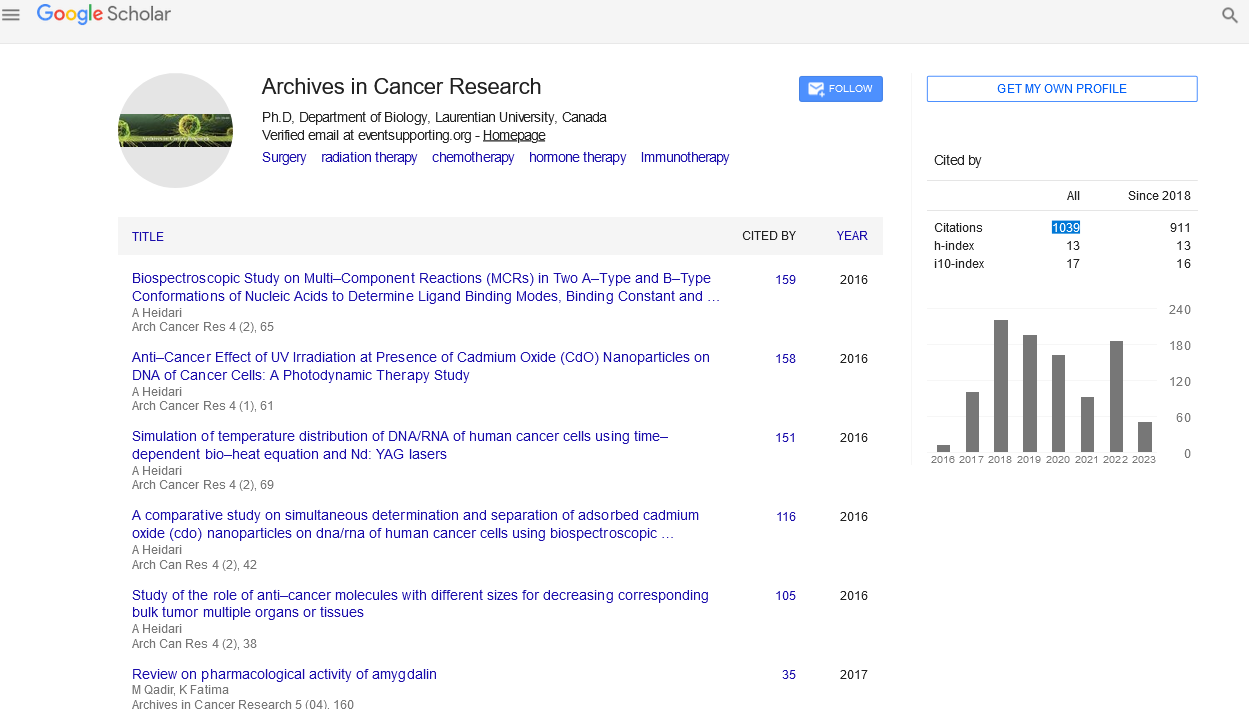Short Communication - (2022) Volume 10, Issue 10
Over the course of 18 years, a perforated cystadenoma of the appendix progressed to pseudomyxoma peritonea.
Helix Mazzone*
Department of Medicine, Critical Care Emory University School of M Lung Cancer and Respiratory Disease Center, Yamanashi Central Hospital, Yamanashi, Japan
*Correspondence:
Helix Mazzone, Department of Medicine, Critical Care Emory University School of M Lung Cancer and Respiratory Disease Center, Yamanashi Central Hospital, Yamanashi,
Japan,
Email:
Received: 29-Sep-2022, Manuscript No. IPACR-22-13103;
Editor assigned: 03-Oct-2022, Pre QC No. IPACR-22-13103;
Reviewed: 10-Oct-2022, QC No. IPACR-22-13103;
Revised: 17-Oct-2022, Manuscript No. IPACR-22-13103;
Published:
27-Oct-2022, DOI: 10.36648/2254-6081-10.10-150
Abstract
In the past, glycoprotein appendiceal neoplasms (MAN) bigger than two cm in diameter were treated by a right colon surgical procedure. New information shows that treatment choices area unit to be determined by the histopathologic grade of the appendiceal tumour and therefore the condition of the wall of the appendix. A 39-year-old lady had associate degree incidental identification of a inferior appendiceal glycoprotein tumor (LAMN) at the time of a extirpation. The appendiceal tumour had little quantities of secretion encompassing associate degree enlarged appendix. No tumour cells were seen within the secretion by histological study. The patient was placed in follow-up. Eighteen years later she needed treatment for advanced pseudomyxoma peritonei
Keywords: Cytoreductive surgery; Peritoneal metastases mitomycin C; Hyperthermia; Radical appendectomy
Introduction
The management of glycoprotein appendiceal neoplasms (MAN) has modified on many occasions over the past three decades. Before 2004, the quality of surgical management for a tumour two cm or bigger was a right colon surgical procedure with associate degree ileocolic node dissection. Principle for the proper colectomy with node dissection was the likelihood of occult positive bodily fluid nodes. As information was gathered on massive numbers of patients with MAN with or while not right colon surgical procedure, no distinction in survival was apparent. Later, many alternative manuscripts created identical information. The necessity for right colon surgical procedure as treatment for MAN is currently determined by 2 factors.
The histopathologic grade of the appendiceal tumour and therefore the condition of the wall of the appendix (intact vs. breached). relating to histopathology, the appendiceal tumors have by serosa Surface medical specialty cluster International (PSOGI) and yank Joint Commission on Cancer (AJCC) eight edition, totally different grades: inferior appendiceal glycoprotein tumor (LAMN), glycoprotein appendiceal cancer (MACA), well, moderately or poorly differentiated or glycoprotein appendiceal cancer with ring cells (MACA-S). If the resected appendix shows MACA poorly differentiated or MACA-S, a right colectomy with complete ileocolic node dissection is indicated so as to get rid of attainable occult regional node involvement. With LAMN or with MACA well or moderately differentiated, the chance of occult ileocolic node metastases is a smaller amount than fivehitter. With these three histological grades the second issue, intact vs. broken wall of the appendix, becomes a determinant for treatment even if LAMN and well or moderately differentiated MAN have a coffee incidence of node metastases, serosa metastases occur frequently if tumour cells from the lumen of the appendix area unit ready to enter the serosa area [1-4].
The MD at the time of extirpation and therefore the diagnostician at the time of pathologic assessment of the resected appendiceal specimen should rigorously assess the condition of the wall of the appendix. Also, secretion among the serosa area is assessed for volume, distribution and presence vs. absence of animal tissue cells. Any suspicious nodules on the peri appendiceal tissues should be sampled. If no proof for perforation of the wall of the appendix exists, this cluster of patients doesn’t want associate degree operative intervention to treat serosa metastases. However, if the wall of the appendix has been broken, patients need a reoperative procedure to produce bar against serosa metastases. The optimum intervention is radical extirpation with appendiceal and ileocolic node sampling, bigger omentectomy and hyperthermic intraperitoneal therapy. During this case report a patient with LAMN and little amount of extraappendiceal no cellular secretion followed for eighteen years. When this prolonged police investigation, treatment of advanced pseudomyxoma peritonei was needed [5]. The serosa cancer index (PCI) was firm prospectively at the time of abdominal exploration. The PCI was associate degree assessment of the distribution and extent of serosa dissemination in thirteen abdominopelvic regions recorded by the MD at the time of abdominal exploration with the assessment continuing throughout CRS. The PCI was firm by visual review of the abdominal and girdle membrane bone and visceral serosa surfaces. All biopsies should be sent as separate specimens for histological study. If the specimen and adherent secretion is completely no cellular secretion, the tumour nodule is reported within the PCI.
A completeness of cytoreduction (CC) score was firm on the patient. This score was firm by the MD at the completion of the CRS. A CC score of zero indicated no visible proof of sickness. A CC score of one indicated tumour nodules but two.5 millimeter in diameter while not a confluence of sickness at any web site. A CC score {of two of two} indicated tumour nodules between 2.5 mm and 2.5 cm within the absence of a contiguous layer of sickness at any anatomic web site. A CC score of three indicated tumour nodules bigger than two.5 cm or a confluence of sickness superimposed out at any web site among the abdomen or pelvis.
Discussion
Pathologic examination of the appendix disclosed associate degree appendix seven cm long and five millimeter in diameter. There was a swelling of the mid-portion of the appendix to nine millimeter. The secretion accumulation related to the appendix noted within the surgery remained connected to the specimen was just about three cm in diameter. A second mucoid combination closely related to the appendix additionally three cm in diameter was removed at surgery. No gross perforation of the appendix was evident. Histological sections of the appendix disclosed a cavity crammed by a transparent mucoid fluid. The wall of the appendix showed replacement of the plate propria by columnar mucus-secreting epithelial tissue [6,7]. The mucoid mass showed foci of calcification with new bone formation. No atypical cells were gift. At the tip of the appendix was a separate three millimeter nodule known as a tumor tumour. The final pathologic identification was cystadenoma of the appendix with involvement of the serosal surface of the appendix by mucoid exudate. Though gross perforation wasn't delineated, perforation couldn't be dominated out thanks to the noncellular secretion documented outside of the appendix. Little tumor tumour was break away the cystadenoma. After abundant discussion the patient was placed into follow-up including CT and carcinoembryonic substance (CEA) tests. In Jan of 1997 (14 years when appendectomy), CT showed a two.5 cm cyst on the proper body part.
A laparoscopic examination was performed by a gynecological medical specialist. This showed a two.5 cm cyst on the proper salpinx. Mucoid excrescences were diffusely gift on right and left ovary and salpinx, on the serosa surface of the bladder, on the face of the proper hemidiaphragm and on the peritoneum. Associate degree calculable one hundred cc of mucoid fluid was gift within the cul-de-sac. A laparoscopic surgical procedure of Fallopian tubes and ovaries, removal of mucoid fluid and diagnostic test of multiple serosa implants was performed. As a result of the Fallopian tubes and ovaries were adherent to the posterior serosa surfaces and therefore the previous extirpation web site, a retroperitoneal dissection was necessary. Histological examination showed multiple sites of LAMN according to pseudomyxoma peritonei.
With an identification of severe hypermenorrhea related to a female internal reproductive organ myoma, this 39-year-old patient was taken to surgery for extirpation by a gynaecologist. Through a Pfannenstiel incision associate degree abdominal exploration was performed. Associate degree enlarged womb with leiomyomas was envisioned. The rest of the exploration was traditional aside from the appendix. It had been elongated and expanded to one.5 cm in diameter. The peritoneum of the appendix was coated by mucoid material. The appendix was removed and subjected to thermoregulator section. No abnormal tissue was detected histologically. Following extirpation and extirpation the abdomen was closed.
This patient had fourteen years from identification of a “cystadenoma of the appendix” with noncellular secretion globules outside of the appendix till laparoscopic identification of pseudomyxoma peritonei syndrome. The implications of this case report area unit obvious for follow-up patients World Health Organization have a person diagnosed by extirpation then, while not additional treatment, area unit placed into follow-up. This minimally aggressive glycoprotein tumor could progress terribly slowly over decades. If associate degree early identification of progression of pseudomyxoma peritonei is to occur meticulous radiologic and tumour marker follow-up is obligatory. The patient during this case report was followed for eighteen years with serial CT and CA19–9 and CEA tumour markers. because the radiologic experience to dependably image MAN has improved, magnetic resonance imaging with diffusion-weighted imaging has emerged because the radiologic procedure of selection for long-run followup of pseudomyxoma peritonei [8-10].
Conclusion
Treatment teams one through four will be delineated for MAN supported the gross associate degreed microscopic pathology of the resected appendiceal specimen and an assessment of the dissemination of mucoid tumour into the serosa area. the dimensions of the person utilized in the past to pick out acceptable management ways is not any longer suggested. Misdraji and colleagues established that the dimensions of the glycoprotein tumour have no prognostic implications [8]. As additional patients area unit suggested for follow-up solely a correct length for the intensive follow-up must be outlined. The magnetic resonance imaging depicts additional tumour deposits and smaller tumour deposits than CT. Also, the radiation exposure that builds up with continual CT examinations doesn't exist with magnetic resonance imaging. The expense of magnetic resonance imaging and therefore the time needed for the examination is larger.
Acknowledgement
I would like to thank my professor for his support and encouragement.
Conflict of Interest
The authors declare that there is no conflict of interest.
REFERENCES
- Gonzalez MS, Sugarbaker PH (2004) Right hemicolectomy does not confer a survival advantage in patients with mucinous carcinoma of the appendix and peritoneal seeding. Br J Surg91: 304-311.
Indexed at, Google Scholar , Crossref
- Shubhada D, Sugarbaker P (2006) Update on the surgical approach to mucocele of the appendix. J Am Coll Surg202: 680-684.
Indexed at, Google Scholar , Crossref
- Kiran K T, Pappas S, Clark G (2013) Right hemicolectomy for mucinous adenocarcinoma of the appendix: just right or too much?. Ann Surg Oncol20: 1063-1067.
Indexed at, Google Scholar , Crossref
- Mark AV, Reetesh KP (2018) An update on the diagnosis, grading, and staging of appendiceal mucinous neoplasms. Adv Anat Pathol25: 38-60.
Indexed at, Google Scholar , Crossref
- Sugarbaker PH (2017) When and when not to perform a right colon resection with mucinous appendiceal neoplasms. Ann Surg Oncol24: 729-732.
Indexed at, Google Scholar , Crossref
- Joseph M, Rhonda KY, Fiona MG, Ulysses JB, Robert HY (2003) Appendiceal mucinous neoplasms: a clinicopathologic analysis of 107 cases. Am J Surg Pathol27: 1089-1103.
Indexed at, Google Scholar , Crossref
- Sugarbaker HP (2006) New standard of care for appendiceal epithelial malignancies and pseudomyxoma peritonei syndrome. Lancet Oncol7: 69-76.
Indexed at, Google Scholar , Crossref
- Sugarbaker HP (2009) Epithelial appendiceal neoplasms. Cancer J 15: 225-235.
Indexed at, Google Scholar , Crossref
- Petr B, František A, Pavel V, Josef M, Kopic J (2019) Pseudomyxoma peritonei syndrome. Adv Surg30: 233-280.
Indexed at, Google Scholar , Crossref
- Riaz AA, Thomas F, Catrin S, Ginimol M, Ahmed K, et al. (2020) The SCARE 2020 guideline: updating consensus Surgical CAse REport (SCARE) guidelines. Int J Surg84: 226-230.
Indexed at, Google Scholar , Crossref
Citation: Mazzone H (2021) Over the Course of 18 years, a Perforated Cystadenoma of the Appendix Progressed to Pseudomyxoma Peritonea. Archives Can Res, Vol.10 No. 10:150





